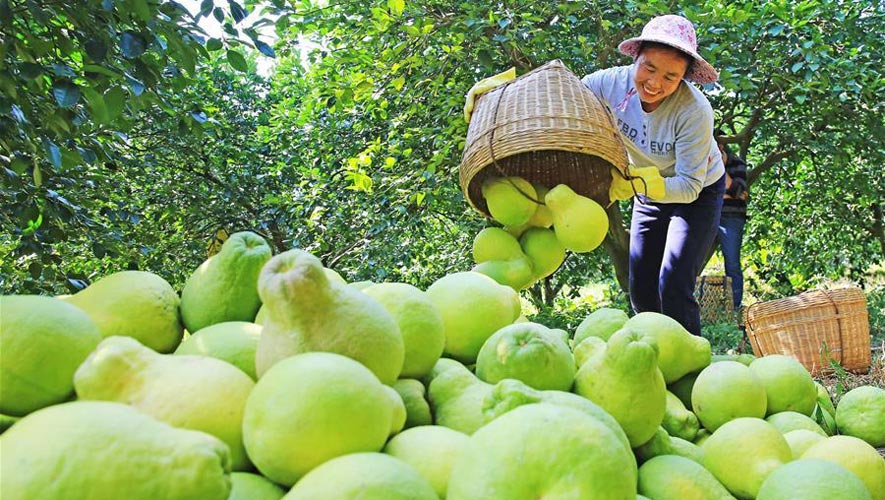More effort needed to develop home-grown consumables both domestically and abroad
For the latest Cambodian Business news, visit Khmer Times Business
In June of 2018, Kratie Koh Trong commune celebrated winning the honour of Geographical Indication (GI) status for their prized pomelos – a status that highlights the virtues of products from a certain region.
This, it was hoped, would elevate the Koh Trong pomelo to the upper echelons of Cambodian produce – the Geographical Indication status has only been granted to two other products: Kampot pepper and Kampong Speu’s palm sugar.
By January 2019, the Khmer Times reported “soaring demand” and a surge in optimism was felt throughout the Koh Trong Pomelo Producer Association, but by September that wave broke and rolled back.
Not a single Koh Trong pomelo can be found in the capital and the popularity of the citrus fruit appears to be limited to its province of origin, Kratie.
This is a story that can be found in many iterations across the Kingdom and is reflective of the state of business promotion here. In fact, the Ministry of Industry and Handicraft (MOIH) has identified marketing as one of the key challenges facing small and medium enterprises (SMEs) on a national scale.
Enhancing local business
“Cambodians don’t support Cambodian products,” said Chhea Layhy, director of the Department of SMEs within the MOIH as he addressed the crowd at a seminar aimed at enhancing local business.
“We must change the national behaviour and, to do that, we must disseminate the quality of local products to local people,” he said, half-jokingly suggesting that people care about what their coffin looks like, but not the products they sell.
Chhea explains “Cambodian consumers often don’t support local businesses, because of factors such as trust – trust in the quality and standards, the lack of attractive packaging and the popularity of our neighbours’ products.
“There has been a lack of promoting this kind of nationalism to support local products. Sadly product promotion is still limited,” he says.
Key problems
This, he argues, is one of the key problems holding back the development of Cambodia’s SMEs – the MOIH reported that 99.8 percent of all businesses nationwide are SMEs of varying scales.
Chhea reveals that the Ministry is currently working on more than 700 certifications and standards across a range of sectors to promote quality products.
For Cambodian-US entrepreneur and Chairman of the American Chamber of Commerce Cambodia, Allen Dodgson Tan, more needs to be done to improve the efficacy of these certifications.
“Certifications can be a complicated thing for a consumer to understand, so I think that simplifying the communication with the consumer is important,” he explains to Capital Cambodia.
“If we design a mark carefully that highlights the standards of a product, then it becomes something that local brands aspire to be a part of – that in and of itself is a form of marketing and a way of building trust.”
Tan’s entrepreneurial efforts have seen him involved in a wide array of enterprises from education nongovernmental organisations to Al’s Tacos – his own take on US-Mexican cuisine that he’s tailored to the Cambodian palate.
Now he wants to see greater cooperation between local brands to further develop the potential of home-grown products.
‘Coalition of brands’
“One of the first ways to address these obstacles is to get together a coalition of original Cambodian brands, traditionally those kind of advocacy groups exist in other countries,” he explains.
“They come together to advocate for their local industry within their various industry groups, so we can’t really raise that awareness without having a certain number of products on board and without making it aspirational to get such a mark of quality on your products.”
Noting that his plan is still in the idea phase at the time of writing, Tan admits the challenge has been assembling the local business community.
“We want them to share that vision, but to do that we have to show them that the local brands could benefit from it – it would probably work as a membership style organisation,” he says.
Even with a willing coalition of local brands, Tan is well aware of the challenges that lie ahead when it comes to tackling perception and believes a sustained marketing campaign, replete with loyalty programmes and multiplatform approaches, would be necessary to convince the Cambodian consumer.
‘National pride’
“I think there is a perception that local brands are not of such a high quality, when compared with international brands – but this is something that exists in many parts of the world, People want German cars, they want Japanese cameras. Those ideas exist everywhere that foreign products are superior but, similarly, I think there is a movement to buy local, support local and I think here there is a national pride.”
Citing the success of Brown Coffee as a prime example, Tan hopes to tap into that sense of national pride with the promotion of Cambodian businesses – a task he feels would best be performed by an association of local brands working collaboratively.
The benefits, he says, will first be felt domestically, but the ambition for exporting home-grown brands is not unrealistic.
‘Finding its feet’
“I think for Cambodia it’s all very new – and this says more about the system as a whole. It’s really only just finding its feet and is only now beginning to move beyond exports coming out of the garments industry,” he says, hoping to bring in more local partners to form a coalition of local brands.
Prashanta Pradhan, country representative of the Doing Business in Asia Alliance (DBiAA), shares this optimism, but highlights three key obstacles to Cambodian exports: standards, international market knowledge and internationalisation strategies.
Through his work with the DBiAA, a consultancy platform for entrepreneurs and investors to expand businesses across Asia, Pradhan has seen a rise in Cambodian businesses adapting to regional or even global standards.
“For a local company to expand overseas with its own brand, the local business needs to put in effort and resources to be the one setting and delivering the standards that work at home and overseas,” he says. Market research into the preferences of regional markets would help determine the level of customisation needed to penetrate the neighbouring countries.
Without a proper strategy for internationalisation, most Cambodian companies may fail to maintain any progress they make abroad, says Pradhan.
‘Good branding strategy’
The tendency for Cambodians to trust more in international brands and products is one that Pradhan disagrees with and echoes sentiments expressed by Tan when he says, “A local brand that can provide a product that appeals to local tastes with consistency, with good marketing and a good branding strategy can command strong preference from local consumers.”
Sadly, that good marketing and branding is a long way off for many Cambodian businesses – according to Phou Sambath, the director of International Business Management Department at the Royal University of Phnom Penh.
“For local companies, many people don’t focus much on marketing for branding purposes. They focus only on marketing for sales,” argues Phou.
“Local businesses don’t realise the power of branding in the long term sense, but they do realise the power of marketing for selling in the short term.”
Marketing popular
He contends that while marketing is a popular aspect of the business course for Cambodian students, many employers don’t recognise the value of it.
“In business school, marketing is widely popular and has been taught for a long, long time in Cambodia, but students majoring in marketing complain that their boss do not understand the concepts of marketing and relationships between marketing and sales and branding.”
Phou believes that there is a persistent belief in the superiority of foreign products and suggests that Cambodian consumers would pick a foreign-made product over a Cambodian equivalent, based on an implied sense of quality.
Local brands, he argues, use nationalism as a strategy and try to connect their products to the Kingdom, citing Cambodia Beer as an example, whereas international brands market themselves on superior quality, design or technology.
Progress is on the horizon though. Phou notes that some local companies, especially real estate developers, food and beverage companies and hotels have been spending more money on marketing campaigns to build their brands in recent years.
‘Improve quality’
“They need to do more to build their brands in the perceptions of local Cambodian consumers and foreign consumers as well,” says Phou.
“But, at the same time, they need to improve the quality of their products to meet a regional or international standards.”




